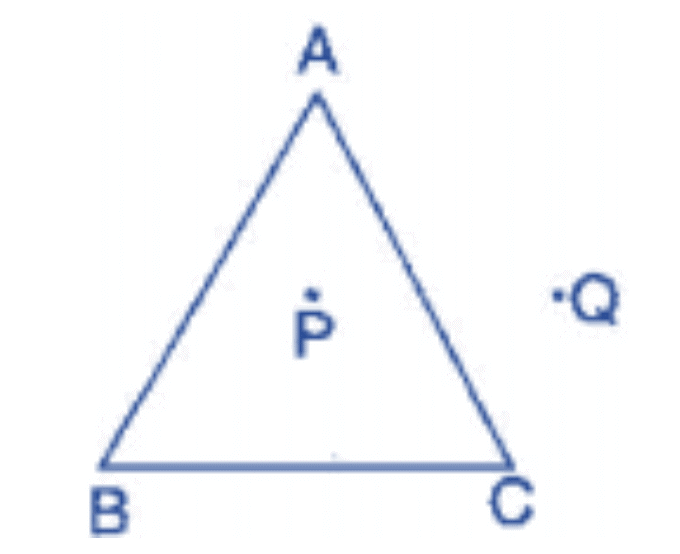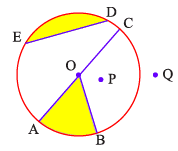NCERT Solutions for Class 6 Maths Chapter 4 - Basic Geometrical Ideas (Exercise 4.4, 4.5 and 4.6)
Exercise 4.4 (Old NCERT)
Ques 1: Draw a rough sketch of a triangle ABC. Mark a point P in its interior and a point Q in its exterior. Is the point A in its exterior or in its interior?
Ans:

A is neither interior of the figure nor exterior of triangle. It is a vertex
Ques 2:

(a) Identify three triangles in the figure.
(b) Write the names of seven angles.
(c) Write the names of six line segments.
(d) Which two triangles have ∠B as common?
Ans: (a) The three triangles are: ΔABC, ΔABD, ΔADC
(b) Angles are: ∠ADB, ∠ADC, ∠ABD, ∠ACD, ∠BAD, ∠CAD, ∠BAC
(c) Line segments are:
(d) Triangles having common ∠B: ΔABC, ΔABD,
Exercise 4.5 (Old NCERT)
Ques 1: Draw a rough sketch of a quadrilateral PQRS. Draw its diagonals. Name them. Is the meeting point of the diagonals in the interior or exterior of the quadrilateral?
Ans:
Diagonal PR and diagonal SQ meet at O, which is inside the quadrilateral.
Ques 2: Draw a rough sketch of a quadrilateral KLMN. State,
(a) Two pairs of opposite sides.
(b) Two pairs of opposite angles.
(c) Two pairs of adjacent sides.
(d) Two pairs of adjacent angles.
Ans: (a) Pair of opposite sides: KL and MN, KN and LM
(b) Pair of opposite angles: ∠K and ∠M, ∠L and ∠N
(c) Pair of adjacent sides: KN and NM, KL and LM
(d) Pair of adjacent angles: ∠K and ∠N, ∠L and ∠M
Ques 3: Investigate:
Use strip and fasteners to make a triangle and a quadrilateral.
Try to push inward at any one vertex of the triangle. Do the same to the quadrilateral. Is the triangle distorted? Is the quadrilateral distorted? Is the triangle rigid?
Why is it that structures like electric towers make use of triangular shapes and not quadrilateral?
Ans: O is common to both the angles ∠AOC and ∠BOC.
No, the triangle is not distorted but the quadrilateral is distorted and also the triangle is rigid.
Structures like electric towers make use of triangular shape so that they could not be distorted and they could be rigid.
Exercise 4.6 (Old NCERT)
Ques 1: From the figure, identify:

(a) The centre of circle
(b) Three radii
(c) a diameter
(d) a chord
(e) Two points in the interior
(f) a point in the exterior
(g) a sector
(h) a segment
Ans:
(a) O is the centre.
(b) Three radii: OA, OB and OC
(c) A diameter: AC
(d) A chord: ED
(e) Interior points: O, P
(f) Exterior point: Q
(g) A sector: OAB
(h) A segment: ED
Ques 2: (a) Is every diameter of a circle also a chord?
(b) Is every chord of circle also a diameter?
Ans: (a) Yes, every diameter of a circle is also a chord.
(b) No, every chord of a circle is not a diameter.
Ques 3: Draw any circle and mark:
(a) Its centre.
(b) A radius.
(c) A diameter.
(d) A sector.
Ans:
(a) Its centre is O.
(b) A radius is OB.
(c) A diameter is AC.
(d) A sector OAB.
Ques 4: Say true or false:
(a) Two diameters of a circle will necessarily intersect.
(b) The centre of a circle is always in its interior.
Ans: (a) True
(b) True
|
276 docs|155 tests
|
FAQs on NCERT Solutions for Class 6 Maths Chapter 4 - Basic Geometrical Ideas (Exercise 4.4, 4.5 and 4.6)
| 1. What are some basic geometric shapes? |  |
| 2. What is the difference between a line segment and a ray? |  |
| 3. What is an acute angle? |  |
| 4. What are the properties of a rectangle? |  |
| 5. What is a polygon? |  |

















